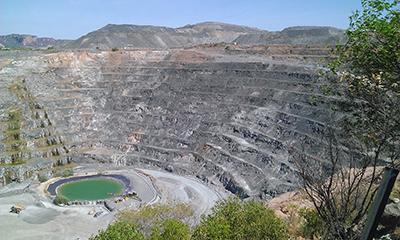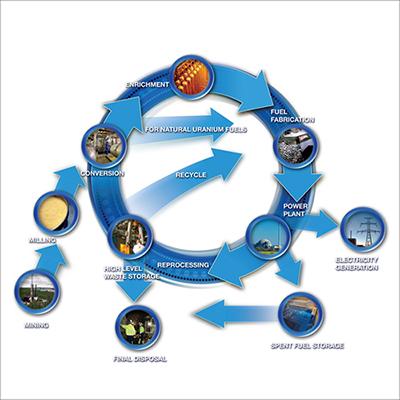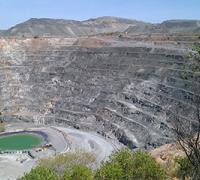What is the Nuclear Fuel Cycle?
Uranium Extraction
Uranium mining is the process of removing uranium from the ground. Different kinds of mines include open cut (also known as open pit), underground, in situ and heap leach mines. Open pit mines are characterised by ore bodies that lie close to the surface, involving a large pit and removal of much of the overlying rock, including a lot of waste rock. Australia’s Ranger mine, the Rossing mine in Namibia and most of Canada’s mines in Northern Saskatchewan are open cut. Underground mining is employed where orebodies are deeper under the surface, involving construction of access shafts and tunnels, but with reduced levels of waste rock. Examples include Australia’s Olympic Dam, Niger’s Akouta, and McArthur River, Rabbit Lake and Cigar Lakes mines in Northern Saskatchewan.

Ranger Uranium Mine, east of Jabiru, Northern Territory. Photo by Cindy Vestergaard, taken on 2 June 2013
Where orebodies lie in groundwater in porous unconsolidated material (i.e. such as gravel or sand), in situ leach (ISL) mining (also known as in situ recovery, ISR) is employed. ISL leaves the ore in the ground by dissolving the minerals in solution and then pumping the pregnant solution to the surface for recovery. There is little surface disturbance and no tailings or waste rock generated with ISL. The orebody however needs to be permeable to the liquids used and located so they do not contaminate groundwater away from the ore deposit. The Beverley and Honeymoon mines in Australia use the ISL method as do most of the mines in Kazakhstan and the United States.
There are also co-product mines where uranium is mined in combination with other minerals such as rare earths, phosphates and copper. Olympic Dam in Australia for example recovers uranium as a by-product of copper as does South Africa from its gold-bearing ores and Morocco from its phosphate deposits. In these cases, the concentration of uranium is usually low, up to a tenth of that in orebodies mined primarily for uranium. The term ‘co-product’ or ‘by-product’ is essentially an economic classification where the primary minerals are higher in economic value. When an orebody contains significant concentrations of two or more valuable minerals, the cost of recovering each individual mineral is reduced as specific treatment processes can be shared. Accordingly, lower concentrations of uranium can be recovered as a by-product at a competitive cost.
Uranium Milling and Concentration
After uranium is extracted from the ground, it is usually processed into uranium ore concentrate (UOC), containing uranium oxide, primarily ammonium diuranate (ADU) and U3O8 (often called yellowcake), but also uranyl peroxide (UO4). Uranium rock from an open cut mine will be milled, i.e. crushed and ground into small particles, before chemically leached with sulfuric acid to dissolve the uranium oxides into a liquid slurry in which the uranium ore is concentrated. The pregnant liquid from ISL or heap leaching is treated similarly. The uranium is then precipitated and then finally filtered and dried.
Conversion
Conversion is essentially a chemical process that alters UOC chemically and/or physically into a gas form. UOC is transformed using a chemical process into either uranium hexafluoride (UF6) gas or into an intermediate product that is then further transformed into UF6. UF6 is a gas that can be the feedstock for centrifuges at uranium enrichment plants. The conversion process will depend on the level of purity required in the UF6, which is based on the specific needs of the enrichment facility.
Enrichment and Reprocessing
Making nuclear fuel or nuclear weapons requires access to an isotope or mixture of isotopes capable of nuclear fission; such fissionable material does not exist in nature. The isotope uranium-235 (235U, or U-235) is fissionable. The natural uranium extracted from the earth through mining and then concentrated into UOC contains minute quantities of the isotope U-234, about 0.7 per cent of U-235, and 99.3 per cent of U-238. For use in nuclear reactors or nuclear weapons, the percentage of U-235 in the UF6 has to be increased through enrichment. Low-enriched uranium (LEU) is uranium that has been enriched to less than 20 per cent U-235 (typically only 3–5 per cent). It is suitable for use in power reactors. Highly enriched uranium (HEU) has been enriched to contain at least 20 per cent U-235. While this is generally considered to be the lowest concentration that can be used in a nuclear weapon, weapon-grade uranium is usually enriched to over 90 per cent U-235.
Plutonium-239, which is produced through the atomic process that takes place inside the core of a nuclear reactor, is also fissionable. For use in weapons, the plutonium produced in a reactor must be separated from other reactor products and recovered by reprocessing the reactor fuel.
Nuclear Power
Today 432 nuclear power plants operate globally, requiring an annual production of 66,512 tonnes of uranium or 78,438 tonnes U3O8. (WNA website accessed August 25, 2013). As of April 2012, 62 nuclear power reactors are under construction and 160 are on order or planned.


